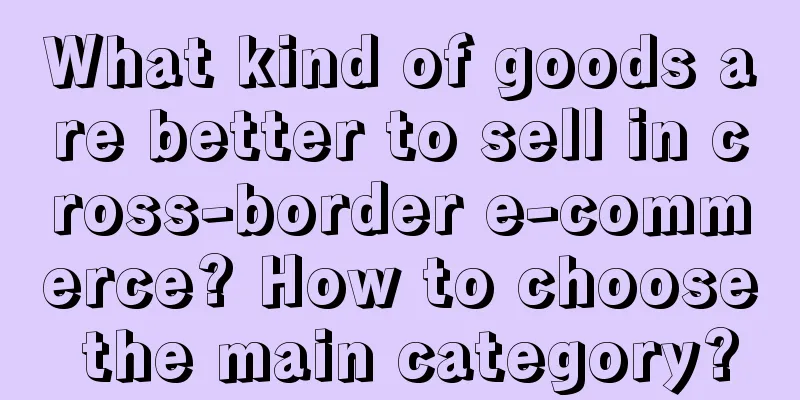What kind of goods are better to sell in cross-border e-commerce? How to choose the main category?

|
Cross-border e-commerce has become a global business model, giving more and more people the opportunity to participate in international trade. However, when choosing goods to sell, many people may be confused: which kind of goods is easier to sell? This article will discuss this issue. 1. What kind of goods are easier to sell in cross-border e-commerce? First of all, it should be made clear that choosing the goods to sell is not a "one-size-fits-all" answer, but requires comprehensive consideration of multiple factors such as market demand, personal interests and experience, product features, etc. The following are some common cross-border e-commerce popular categories for your reference: Fashion clothing and accessories: The fashion field has always been one of the hot areas of cross-border e-commerce. It has a high consumption frequency and a large market size, and it is also relatively easy to promote and market brands. However, due to fierce competition, to succeed in this field, unique product design and supply chain management capabilities are also required. Home Furnishings and Decorations: Home furnishings and decorations are also one of the popular categories in cross-border e-commerce. As people pay more attention to their home environment, the market demand in this field is also growing. Choosing unique and high-quality products and paying attention to the differences in local culture and style can help you succeed in this field. Beauty and personal care products: Beauty and personal care products is a cross-border e-commerce sector with high profit margins and stability. However, due to issues such as health and safety, high requirements are placed on product quality and certification. Therefore, it is very important to ensure that your supply chain and products comply with relevant regulations and standards. Healthy food and health products: As people pursue a healthy lifestyle, the market demand for healthy food and health products is gradually growing. However, when choosing this field, you need to pay attention to product certification and compliance, as well as a deep understanding of the health needs of local consumers. 2. How to choose the main category? In the selection When considering cross-border e-commerce categories, you can consider the following aspects: Personal interests and experience: Choosing an area that you are familiar with and interested in will allow you to be more engaged and focused. At the same time, your personal experience and expertise can also help you better understand market demand and consumer psychology. Market demand and trends: Understand the current market demand and trends through cross-border e-commerce market research and analysis. Choosing a field with a large market size and potential can increase your sales opportunities and competitive advantage. Product uniqueness and differentiation: Find a field where you can offer unique products and differentiated competitive advantages. This will reduce direct competition with other sellers and attract more consumer attention and purchases. Feasibility and operating costs: Evaluate the feasibility and operating costs of the main business category. Consider your funds, resources and capabilities, and choose a main business category that is relatively feasible and has low cost control in terms of supply chain management, logistics distribution and after-sales service. Laws, regulations and compliance requirements: Ensure that the main categories you choose comply with local laws, regulations and compliance requirements. Avoid choosing areas involving intellectual property infringement, counterfeit and substandard products or contraband to avoid possible legal risks and disputes. Competition and market gaps: Understand the competition and market gaps in your chosen field. Look for a field that has a certain degree of competition but also has sufficient market opportunities so that you can stand out from the competition and gain better development opportunities. Choosing the main category of cross-border e-commerce requires comprehensive consideration of personal interests, market demand, product uniqueness and feasibility. By deeply understanding the market situation, conducting market research and analysis, you can find a main category that suits you and has market potential. Continuously learning and updating knowledge, and flexibly adjusting and optimizing business strategies will help you succeed in the field of cross-border e-commerce. Recommended reading: Which platform should I choose for my personal cross-border e-commerce business? What are the requirements for entry? How much does it cost for personal cross-border e-commerce? Do I need a deposit? Can cross-border e-commerce personal trademarks be registered? What are the regulations? |
<<: Do cross-border e-commerce purchases require invoices? How do I pay taxes?
>>: Is cross-border e-commerce difficult to do now? What is the prospect of cross-border e-commerce?
Recommend
The halo of a big company is not popular in small companies
This year, the salary in the job market has been s...
How to do an excellent data analysis project?
To do a good data analysis project, it is not just...
How to create an Amazon detail page? How to create pictures?
Now, there are indeed many friends who have made a...
Why do you run Xiaohongshu? 7 recent experiences on running Xiaohongshu!
I have been in frequent contact with merchants and...
New Year's co-branded models: the undefeated Chinese style, the people-friendly cartoon style, which one do you pick?
The Spring Festival is a traditional festival that...
One year after TikTok Shop entered the US, where is content e-commerce heading?
As TikTok Shop develops steadily in the US, it is ...
This generation of post-90s chooses a cemetery in the live broadcast room
This article starts from the merchants who provide...
Will Shopee lose points if the product is removed from the shelves after being put on the shelves? How to avoid the deduction?
Many merchants who serve foreign customers now hav...
Is it difficult to convert existing users into new ones at low cost?
In the stock era, when traffic is scarce, is it di...
How to chat with users?
The relationship between people and brands is a lo...
Why does JD.com promote procurement and sales?
In the wave of e-commerce live streaming, JD.com&#...
Live streaming has become Uniqlo's lifeline in China
The shared bike industry has gone through 8 years ...
Sexy Coconut Tree is live streaming on Taobao, auctioning off the "right to dance", and the same "hormone vest" is selling like crazy
Coco Tree has tried more live broadcast formats on...
How is it to be a seller on WishGo? How does Wish earn its commission?
WishGo has attracted many sellers with its unique ...
How does Pinduoduo prevent price comparison?
This article deeply explores the price comparison ...









